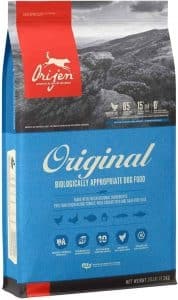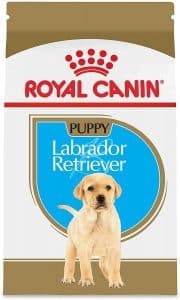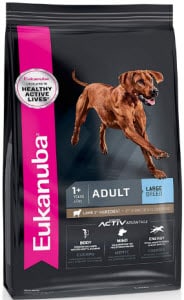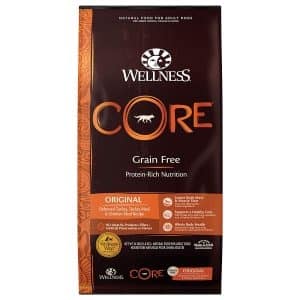Last Updated on February 17, 2022 Ashley Camelia
If you own a lovely Labrador, probably the first concern you have is regarding the best dog food for labs. Not all dogs are the same and hence the Labrador dog food you choose will have to be customized based on the specific needs of your dog.
While the market shelves will bombard you with promises of the best dog food that promise the best activity levels and fur quality to you, the truth remains that there is no single best dog food for labradors. However, you can check out the best Labradors foods on Amazon.com here.
To make the choice easier for you, you must look for Labrador food that is good quality and contains wholesome ingredients. However, this is the most confusing aspect where you have to choose out of the overwhelming list of claiming good dog foods for labs and determine if they have the good quality they boast.
The 5 Best Dog Food for Labs Review
Labradors are known to be a friendly, affectionate, and fun-loving breed with a good appetite. However, this breed is prone to health issues such as arthritis, weight troubles, and allergies. Establishing a well-designed diet plan during puppyhood is thus quite essential to ensure a long and healthy life for these pups. The following are our recommendations:
Important Features to Consider Before Choosing Labrador Food
Here are some important features to consider before choosing the foremost dog food for labs:
- Wet vs. dry food: A very young puppy is just making the transition from mummy’s milk and it is important to eat soft food. Do not go for hard dog food for such young pups. However, after a few months, it needs to move to hard food to aid teething. Make sure that the transition is accomplished by moving to food that is soft yet dry.
- Grain-free. Your dog can digest grains but it is important to restrict the quantity as for a major part they are just carbohydrates. They are inexpensive and hence used as fillers in dog foods. Your dog’s body needs more meat, fruits, and veggies to fulfill nutritional requirements.
- Omega-3s. Omega 3 fatty acids are important for fur babies. They effectively aid brain development. These are mostly found in fish oil and also help in the development of a vision for your dog. Look for it in the ingredients list of dog food you consider along with DHA to ensure proper brain and vision development for your dog.
- Serving size: Puppies can hardly self-regulate whereas older dogs know exactly when they are full. It is important to stick to a feeding schedule and a fixed portion based on your dog’s age and weight. Remember not to overfeed your dog.
#1: Best Overall – Orijen (Original)
Orijen is a very nutrient-rich Labrador dog food that includes fresh meat from free-run chicken and turkey, fresh fish caught wild and cage-free eggs. It takes care of the natural needs of dogs with high-quality animal ingredients.
The dog food make from 85% premium animal ingredients are fresh and raw and sourced from the best and most trusted sources. This is another wholeprey diet inclusions like meat, organs, cartilage, and bone providing your dog with complete nutrition.
| Lifestage | For dogs at all life stages |
| Protein | Chicken, Turkey, Fish (flounder) |
| Other Ingredients | Whole red lentils, whole navy beans, whole pinto beans, whole green lentils, whole chickpeas, chicken fat, natural chicken flavor, pollock oil, lentil fiber, ground chicken bone. |
- Grain-free OR with grains (85% premium animal ingredients)
- Doesn’t contain high-glycemic fillers
- The bag mentions the protein contribution of each ingredient and thus makes it possible to track the intake
- No stomach upset issues or skin allergies in dogs
- Maintains energy throughout the day
#2: Best for Puppy Labs – Royal Canin Labrador Retriever
This dog food for Labrador is ideal for 8 weeks to 15 months of age. After 15-month old, you can switch to Royal Canin Labrador Retriever (Adult).
It is conducive to healthy joint function and helps mobility. One of the features users love is how it promotes the healthy development of skin and coat. Formulated in sync with veterinarians, breeders, and pet experts to understand the impact of individual ingredients based on breeds, it addresses breed-specific needs.
The Kibble is uniquely designed to suit the facial and jaw structures of dogs and their biting patterns. In all, it ensures complete and balanced nutrition with a mix of dry and wet food.
| Lifestage | Labrador Retrievers 8 weeks to 15 months old |
| Protein | Chicken |
| Other Ingredients | Rice hulls, brown rice, rice, wheat gluten meal, natural chicken flavor, chicken fat, anchovy oil (source of EPA/DHA), dried egg product, corn gluten meal, dried beet pulp (sugar removed). |
- Support your puppy’s natural immune system
- Promotes a healthy and shiny coat
- Most dogs with a sensitive stomach take this food well
- Promotes healthy weight gain and maintains energy levels throughout the day
#3: Best for Adult Labs – Eukanuba
This is one of the best dog food for lab adults (15-month or older) large breed that comes with a 3D Dentadefense system and helps reduce the tartar build-up for cleaner teeth and healthy gums. For active dogs, the food contains natural fiber and a prebiotic blend that can make digestion smoother and ensure healthy skin and coat.
It is formulated with mainly high-quality lamb proteins, glucosamine, and chondroitin sulfate that promote strength and lean muscles. This Labrador retriever food is known to support healthy joint growth.
Also, it is rich in DHA and vitamin E and thus supports healthy brain function that keeps the dogs sharp. So, this is definitely one of the good options to choose from if you are looking for the best dog food for Labs.
| Lifestage | Adult, and senior dogs |
| Protein | Lamb & Rice |
| Other Ingredients | Corn Meal, Ground Whole Grain Sorghum, Ground Whole Grain Barley, Chicken By-Product Meal, Dried Beet Pulp, Fish Meal, Dried Egg product. |
- Protein-rich
- The dog coat becomes really healthy and shiny
- Dogs allergic to other dog foods take it really well
- Very easy to digest and doesn’t cause loose stools
- It is one of the best dog food for Labs (especially for active dogs)
#4: Best for Toy, Small & Large Breed – Blue Buffalo Wilderness
This dog food is considered one of the best dog foods for labs as it is high in protein. This is your best bet if you are looking for a chicken-free option. It is formulated with bison meat and helps build lean muscle mass and maintain it.
This is grain-free dog food for Labradors that contains only healthy carbohydrates such as peas and sweet potatoes. It is rich in omega 3 and 6 fatty acids that are conducive to glowing skin and a healthy coat.
This food comes with a unique feature called the LifeSource Bits which is the right blend of vitamins, minerals, and antioxidants. Good immune system health is assured with this dog food. It also helps maintain a healthy oxidative balance. It is free of chicken and poultry bi-products and also doesn’t contain any artificial flavors or preservatives.
| Lifestage | Puppy, adult, and senior dogs |
| Protein | Bison (Flavor) |
| Other Ingredients | Fish Meal, Peas, Pea Protein, Dried Egg Product, Canola Oil (source of Omega 3 Fatty Acids), Tapioca Starch, Natural Flavor Pea Starch, Dried Tomato Pomace, Flaxseed (source of Omega 6 Fatty Acids), Potatoes, Beef Meal. |
- Grain free formulas
- Perfect dry food for all life stages of Labrador dogs
- All-natural ingredients
- Superior quality than many other ingredients in the market
- Dogs get full faster as compared to other brands
#5: Great Alternative – Wellness Core Grain Free (Original)
This is grain-free dog food for Labrador adults that ensures complete nutrition for the dog. It is rich in protein and contains real chicken and turkey meat additionally as veggies and vitamins and minerals.
The best feature is that it is devoid of any artificial flavor, colors or preservatives. It is not very high on calories, still very rich in nutrition.
| Lifestage | Puppy, adult, and senior dogs |
| Protein | Turkey (Flavor), Chicken |
| Other Ingredients | Potatoes, Peas, Dried Ground Potatoes, Carrots, Apples, Chicken Fat (preserved with Mixed Tocopherols), Tomato Pomace, Chicken Liver, Flaxseed, Salmon Oil, Sweet Potatoes, Kale, Broccoli, Blueberries, Spinach, Parsley. |
- Grain free
- Flatulence issues were reduced in dogs after changing from other dog foods to this one
- Noticeably better and healthier coat
- Works well for dogs with multiple allergy issues with other brands
- Dogs are fond of the flavor
7 Best Dog Food for Great Danes
5 Best Dog Food for American Bully
The Best Low Protein Foods for Dog
Best Dog Food for Labrador Retrievers: Buyer Guide
As a part of your journey as a pet parent, you will often have to demand some food demands of your pup. While it may be one of the toughest things to do, it is a good idea to follow to maintain good health for your dog. Some foods that may seem healthy may be toxic for your dog.
You may indulge the dog in occasional treats but it is your responsibility to make the right food choices. It may be a little more complex to choose the ideal Labrador dog food as compared to other dogs. The complexity comes in when you have to strike the right balance between protein, carbohydrates, and fats.
The Tips to Make the Right Decision About Labradors Foods
- Labradors gain weight too fast and it is important to maintain an exercise routine to keep them healthy.
- Labradors need a diet rich in fats and proteins because they are a large breed that spends a lot of energy across the day.
- All Labrador dogs are different and hence each needs to have a customized Labrador retriever diet
- 30-40 calories per pound of body weight are ideal to help Labradors maintain their active lifestyle.
- Labradors are prone to obesity, it is very important to restrict the portions for them to avoid future health issues.
- Protein is very important to maintain muscles in your lab puppy.
- Ideal Labrador puppy food should also focus on fat content. 10-15% of fat content is ideal for your labrador.
- It is important to minimize the carbohydrate content on your lab puppy’s diet.
Ingredients to Look for in Labrador Dog Food
A Labrador retriever diet must preferably contain meat as an ingredient. Other beneficial components of dog food for Labrador retrievers include whole ground grains such as oats and barley, and rice and veggies. Potatoes and peas are common and nutritious components of top dog food for labs.
Other nutritional requirements for Labrador puppies include fatty acids such as Omega-3 and 6. These are most commonly found in herring oil. The mother’s milk for labrador puppies is rich in DHA and is conducive to brain and vision development in the puppies.
Dog food for lab puppies will always be rich in DHA to fulfill this criterion. Also, look out for prebiotics because they work in sync with the good bacteria in the digestive tract of dogs and make their immune systems stronger.
Labradors fall under large dog breeds as the growth of puppies is rapid. This may cause joint strain to the dogs. Food products rich in sources of chondroitin sulfate are ideal to promote healthy joints in dogs.
As dog owners, you must always keep a tab on the calorie intake of your pup to ensure appropriate growth as opposed to plain fat that will only stress your dog’s bones and joints.
Your hunt for the best dog food for labs will introduce you to several brands but it is very important to learn to read the labels so you can choose the best Labrador puppy food.
Common Health Concerns in Labradors
To choose the finest dog food for labs, it is important to keep in mind the health risks they are likely to face. It is important to note that food allergies are more common in Labradors than other logs and you may need to account for the allergens before choosing good dog food for labs.
Here are some common health concerns that your Labrador may face
- Knee problems
- Hips and elbow dysplasia
- Progressive retinal atrophy
- Epilepsy
- Osteochondrosis
- Cataracts
Bloat is another life-threatening condition that your Labrador may be subject to. This is the condition where the amount of air in your dog’s stomach disconnects the blood flow. It usually occurs when the dog eats too much or too fast and takes in too much air.
It is thus important to not feed the Labrador right after exercise. You should also opt for a special eating bowl that will not allow you to eat too much too fast.
Watch Video: Labrador Retriever Health Issues
Frequently Asked Questions (FAQs)
1. Do labs have specific dietary requirements?
Labradors are a large breed and therefore require good amounts of protein to grow appropriately. It takes them above 1.5 years to 22 months to reach their highest size. During puppyhood, their diet requires 22% protein. It is also important to control fat intake in Labradors. Lean mass maintenance is critical during their growing stages and thus 18% protein in the diet is ideal.
2. What should be the contents of the best Labrador dog food?
You must look out for labrador dog food that contains natural and wholesome ingredients. Here are some components you can look for:
- Animal protein
- Fat content in a controlled quantity
- Nutrients that promote joints
- A good balance of nutrients
- Ingredients that can be easily digested
3. Do Labradors require nutrients to support joint health in their everyday diet?
Yes, since Labradors are a large breed, they need to consume calcium and phosphorus in their everyday diet for good and healthy bones and joints.
4. What is the daily calorific requirement of a Labrador?
The calorific requirements of Labradors are due to their size. An adult lab requires above 1500 and under 1600 calories per day. This goes up inactive dogs that can do with about 1900 calories daily whereas goes down for old dogs that must consume within 1100 calories per day. A veterinarian is the best person to ask for advice regarding your specific dog.
The number of calories that your puppy needs can also be calculated as 40 calories per pound. If you multiply 40 to your dog’s weight, you will know about their calorific requirements. The weight should be taken in pounds.
5. What should be the frequency of feeding my Labrador?
The growth rate and energy consumption are fast in Labrador puppies. You should not feed them more than 4 small meals in a day. These are enough to make up for their energy requirements and growing needs. Lab puppies of age between 3-6 months can do perfectly well will 3 meals a day. Puppies older than 6 months do not need more than 2 meals a day.
6. Is there a way to detect food allergies in my Labrador?
Food allergies are normally indicated by common symptoms like puking, loose stools, gastric issues, and a dip in appetite. Skin itches, coughing, sneezing, and recurring ear infections can also indicate food allergies. If it seems to you like a food allergy in your labrador, you should get in touch with a veterinarian.
7. Are there any common ingredients that may cause food allergies in Labradors?
Common allergens for Labradors include beef, dairy, chicken, soy, eggs, and wheat.
8. When should I transition my Labrador from puppy food to adult dog food?
Between 12-18 months is the perfect age for your Labrador puppy to move to adult food and stop taking puppy food. However, before making the change, account for their size and extent of growth.
9. What is the minimum exercise requirement of my labrador?
At least 1 hour of exercise per day is needed for an adult Labrador that is healthy. You can calculate the exercise requirement of your puppy by following a simple rule. The rule mandates 5 mins of exercise per month of existence. The overall health of the dog also plays an important role in determining the level of exercise required for the dog.
10. What is the ideal diet that can be fed to labs?
Labs are versatile in terms of the food they can be fed. You can feed them anything from food cooked at home to raw food. Experts advise that kibble is the best dog food for labs.
11. What is the protein requirement for Labradors and what are the best sources to fulfill it?
High-quality protein for Labradors is found in poultry, lamb, and beef. They need to be combined with other sources of protein such as fish, eggs, and plant proteins for best results. It is wise to adhere to the percentage of 18% of protein for adult dogs and 22% for puppies to avoid health issues such as obesity.
12. Is it recommended to follow completely grain-free diets for labs?
Grain-free diets are not recommended for Labradors unless they have a grain allergy.
13. Which foods are absolutely not allowed to offer to Labradors?
Your labrador must never eat almonds, cinnamon, chocolate, garlic, coffee, green tomatoes, grapes, onion, raisins, nutmeg powder, and macadamia nuts.
14. What vegetables should be ideally fed to Labradors?
The following vegetables are ideal to be fed to labs:
- Potatoes
- Brussels sprouts
- Cauliflowers
- Broccoli
- Green beans
- Asparagus
- Edamame
- Carrots
- Cucumbers
- Sweet potatoes
- Peas
15. What fruits can a Labrador eat?
The ideal fruits for labs are:
- peaches
- cantaloupe
- strawberries
- blueberries
- apples
- blackberries
- bananas
- oranges
Conclusion
While you put in all the efforts into reading and researching about the ideal dog food for labradors, different things work for different dogs. If some food suits your dog and ensures that it is healthy and thriving, stick to it.
Do not go by just brands, sometimes certain foods may work better for your fur buddy as compared to other foods. Do not forget that you are looking for the best dog food for labs because it suits your dog and not because you have someone to impress or a competition to win.





